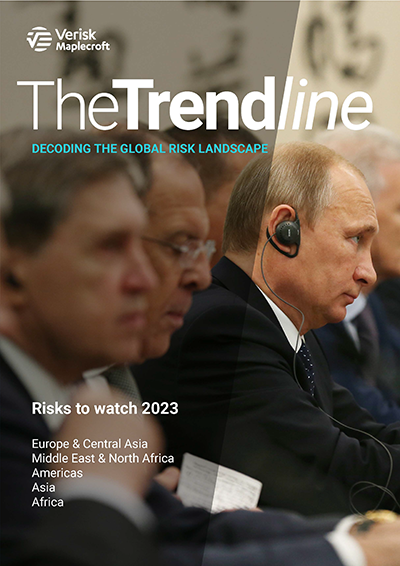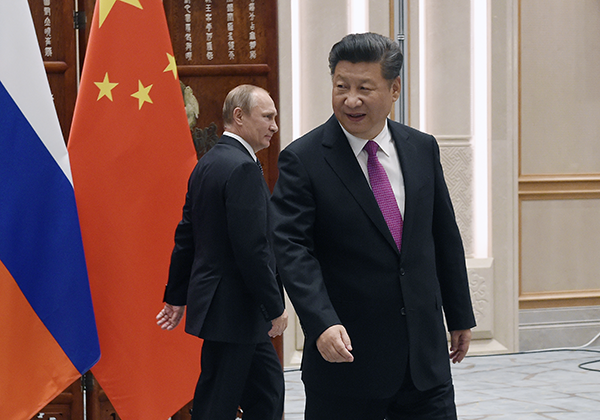The Trendline - Americas: Risks to watch
by Arantza Alonso and Gunther Baumgarten and Jimena Blanco and Eileen Gavin and Mariano Machado and Robert Munks,
The private sector will be caught between domestic political risks and geopolitical tensions, setting up the Americas - but Latin America in particular - for a challenging 2023 on the political and foreign trade fronts. As political violence rises within the region, we expect the election in Argentina to mark the beginning of the end for the ‘second pink tide’. On the trade front, the US’ and Canada’s pushback against China will put the Americas in the bullseye of a much broader geopolitical competition. The silver lining: the region will continue to lead the way in sovereign thematic bonds, with Brazil returning to the big stage of environmental policy debates.
Democratic recession ignites political violence
The Americas have experienced an unprecedented uptick in political violence over the past two years, with our index showing that 16 of the 35 countries experienced an exceptional to significant increase in risk, including four of the five largest economies (the US, Canada, Brazil and Argentina).
Figure 1 shows how the erosion of public trust in formal institutions is rendering these mechanisms to channel discontent, such as a free and open press, functioning unions, and independent courts, increasingly irrelevant. This trend has been fuelling high levels of civil unrest since 2018. A new area for concern is how fringe groups exploit the situation to undertake direct attacks on democratic institutions, including the now infamous assaults on the US capitol (2021) and Brasilia’s Square of the Three Powers (2023), and a failed attempt to assassinate Argentina’s Vice President, Cristina Fernández de Kirchner (2022).
As political polarisation becomes entrenched, the veracity of formal institutions comes increasingly under question. The risk in 2023 is that political violence escalates during key electoral processes in Guatemala, Paraguay, and Argentina – and a likely early ballot in crisis-stricken Peru.
The beginning of the end of the second pink tide
While left-wing leaders celebrate the return to office of Brazil’s Lula da Silva, a ‘founding father’ of Latin America’s Pink Tide, this second political wave is all but certain to start turning sour in 2023. As Figure 2 shows, there are more differences than similarities between the two waves, and populist currents (on the left and right of the political spectrum) cannot survive without spending power and legislative muscle.
The inability of left-wing governments to resolve long-pending social demands – exacerbated by the pandemic and the cost-of-living crisis – will sustain the anti-incumbent sentiment that brought them back to power in the first place. We expect the October election in Argentina to mark the beginning of the end – unless an early election in Peru beats Buenos Aires to the punch.
The key question is whether this shift will consolidate a new period of alternation in power, between left-wing and right-wing coalitions, or consolidate the nascent trend of ‘outsider’ anti-system figures securing the top job. If Peru’s recent descent into political chaos is anything to go by, the second option can be far more damaging from a social, political and economic perspective than the alternation between well established – albeit ineffectual – political leaders. As a result, business and investors are exposed to a potential exacerbation of extreme polarisation, risking a vicious cycle in which the further weakening of institutions aggravate the problems that pushed voters away from political parties and towards these anti-system leaders in the first place.
Latin America unlikely to hit nearshoring jackpot in 2023
Our data shows that multiple obstacles will undermine the region’s ability to capitalise on the US’ and Canada’s itch to decouple from China in 2023. High criminality, inflamed civil unrest risks, deficient transport infrastructure, rising vulnerability to climate disasters, and weak labour controls will steal the region’s thunder.
Our Crime Index – which measures homicides, property damage and theft – shows that 15 of the 20 most crime-stricken countries in the world are in the Americas. Growing perceptions of insecurity amid a rising presence of organised crime is chief among the challenges to nearshoring.
Mexico, the country with the largest potential gains from nearshoring – around USD35.3 billion for increased exports, according to the IDB – also saw the economic cost of violence reach USD2.43 billion in 2021. The region’s operational and financial challenges for businesses, and the social costs for employees, will continue driving associated impacts for political stability and prove the weak link in investor confidence when evaluating decoupling options.
Geopolitics: Securitisation of trade policy
Global power competition will make its mark on business operations in the Americas in the year ahead, as Canada and the US push back against China’s expansion. The application of national security criteria to trade and foreign investment policies will become more widespread, with critical transition minerals and semiconductors under the spotlight.
Ottawa recently targeted Chinese investment in lithium mining. More sectors will soon fall under national security review under the Investment Canada Act. Washington’s recent export controls and entity designations have targeted China’s access to high-end semiconductors. Thwarting China’s military modernisation is the goal.
China is likely to back down from an all-out ‘chip war’ that it cannot currently win. But securitisation of aspects of the business environment is a long-term trend. It will bring opportunities further south in the hemisphere, where the new approach will feed into linked debates around supply chain security, near-shoring and resource exploitation.
The Sovereign ESG landscape: Looking to Lula for ESG leadership
For ESG-focused investors, Brazil will be the sovereign to watch in 2023, with huge appetite for green and sustainable debt opportunities. Investors anticipate a dramatic shift in environmental policy, with Lula pledging to end deforestation and protect indigenous rights. But Brazil has a long way to go to reverse the damage done by Bolsonaro. Our Sovereign ESG dataset shows a three-point overall score drop for the country in the past 12 months to just 40/100, for a weak overall rating of ‘3-‘. Invariably, the E pillar was the major drag (-7 points), but with declines also in the S and G.
Middle-income Lat Am sovereigns will continue leading the way on thematic bonds in 2023. Uruguay’s October 2022 USD1.5 billion sustainability-linked bond – which used an innovative two-way pricing structure by way of a step-down coupon to incentivise environmental improvement, and a stepup to penalise underperformance – sets a precedent for other sovereigns to consider similar instruments, as investors row in behind the idea that stronger environmental performance can mean lower credit risk.





